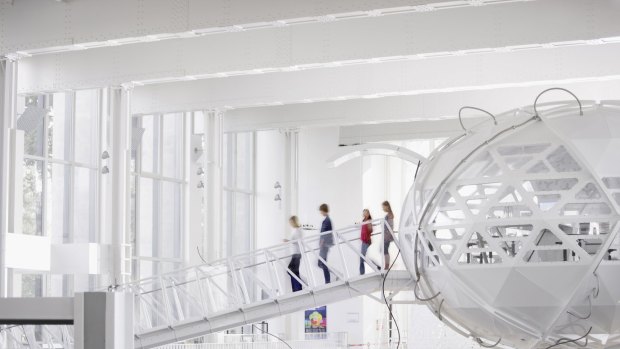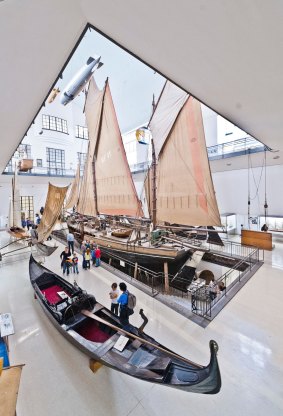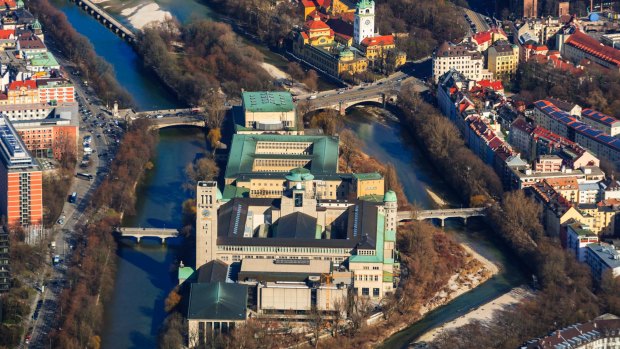This was published 8 years ago
Munich's Deutsches Museum: The world's largest museum of science and technology
By Tim Richards

Munich's family-friendly Deutsches Museum has more treasures than can be explored in just one day.Credit: Getty Images
I clap my hands over my ears at the loud crackling sound, as a great arcing blaze of electrical power strikes a suspended metal sphere. However, the man seated inside its confined space survives thousands of volts of pure, deadly force.
There will be no electrocution today.
It's a regular demonstration at Munich's Deutsches Museum, but no less spectacular for its harmless outcome. The staff member guinea pig lives on courtesy of the Faraday Cage created by the sphere's metal mesh, which allows the electricity to disperse harmlessly along its surface.

The navy exhibition at the Deutsches Museum.Credit: Alamy
This combination of showmanship with solid science is a hallmark of this institution, the world's largest museum of science and technology. Founded in 1903 at the height of the German Empire, its main campus is an impressively huge building located on an island in the Isar River.
Having been around for so long, there's a certain tension between its historic exhibitions and those depicting the current state of science.
On one hand, vast halls are populated by maritime and airborne craft of the past; on the other, temporary exhibitions such as Welcome to the Anthropocene focus on the human impact on our world, including contemporary challenges such as climate change.
For sheer steam-punk sexiness, these instruments have no equal.
Head in the stars
With such a wealth of choices, it's hard to know where to start. So I indulge a pet interest and take the lift up to Astronomy.
A series of displays does a great job of demonstrating the scale of the universe, making the visitor feel quite insignificant. Yet I'm more strongly drawn to the cases of historical instruments: wonderful contraptions of brass, glass and wood.

Deutsches Museum.Credit: Alamy
As well as celestial globes from the 1700s, there are enormous telescopes, quadrants and heliometers, which were used to measure the sun's diameter. These instruments have now been replaced by electronic equivalents – but for sheer steam-punk sexiness, they have no equal.
The museum's planetarium is completely up-to-date, having recently been installed with a new projector. As the audience leans back, the curved ceiling is lit by crisp images of planets and stars in motion. As the southern hemisphere gets its moment in the spotlight, I feel a pang of fondness toward the Southern Cross.
Magnificent flying and floating machines
Down on the first floor, in Aeronautics, the focus is back on the physical. From the ceiling of this lofty space hang models of aircraft, including Germany's famous airships. Beyond a huge airship propeller blade hang full-size replicas of the Wright Brothers' pioneering plane, and of the Red Baron's First World War biplane.
Directly below this level is the Maritime section. The void between the two areas creates the marvellous effect of a jumble of aircraft flying above a jumble of boats, as if a time experiment has gone wrong and disgorged them all at once.
Star of this section is the wooden fishing boat Maria, which worked in the North Sea from the 1880s to the 1950s. One side of the vessel has been removed, to display the below-deck interiors.
Behind it is the steel-hulled Renzo, a steam-driven tugboat from 1931; and both are surrounded by numerous smaller vessels including canoes, kayaks and gondolas.
I'm starting to realise this museum is not one of those you thoroughly cover in a day. It's family-friendly, but more in the scale of its surprises than in the number of buttons you can push. For curious minds of any age, it has plenty to impress.
TRIP NOTES
MORE INFORMATION
GETTING THERE
Qantas (131313, qantas.com.au) and partners fly from Melbourne to Munich from $1600 return.
STAYING THERE
GHotel, Baaderstrasse 88, Munich, Germany, +49 89 127180, ghotel.de. From €89 per night.
Hotel Blauer Bock, Sebastiansplatz 9, Munich, +49 89 231780, hotelblauerbock.de. From €67 per night.
VISITING THERE
Deutsches Museum, Museumsinsel 1, Munich, deutsches-museum.de. Open 9am-5pm daily, entry €11.
Tim Richards travelled courtesy of the German National Tourist Board.
FOUR MORE MUNICH MUSEUMS INVOLVING SCIENCE AND TECHNOLOGY:
BEER AND OKTOBERFEST MUSEUM
Explores brewing and beer culture from ancient times to the present day. Sterneckerstrasse 2, bier-und-oktoberfestmuseum.de.
BMW MUSEUM
Details the history of the famous German make, inside sleekly futuristic premises. Am Olympiapark 2, bmw-welt.com.
PINAKOTHEK DER MODERNE
Four museums in one location, covering modern art, graphics, architecture and design. Barer Strasse 40, pinakothek.de.
PALAEONTOLOGICAL MUSEUM
Filled with fossils of prehistoric plants and creatures. Richard-Wagner-Strasse 10, palmuc.de.
Sign up for the Traveller Deals newsletter
Get exclusive travel deals delivered straight to your inbox. Sign up now.